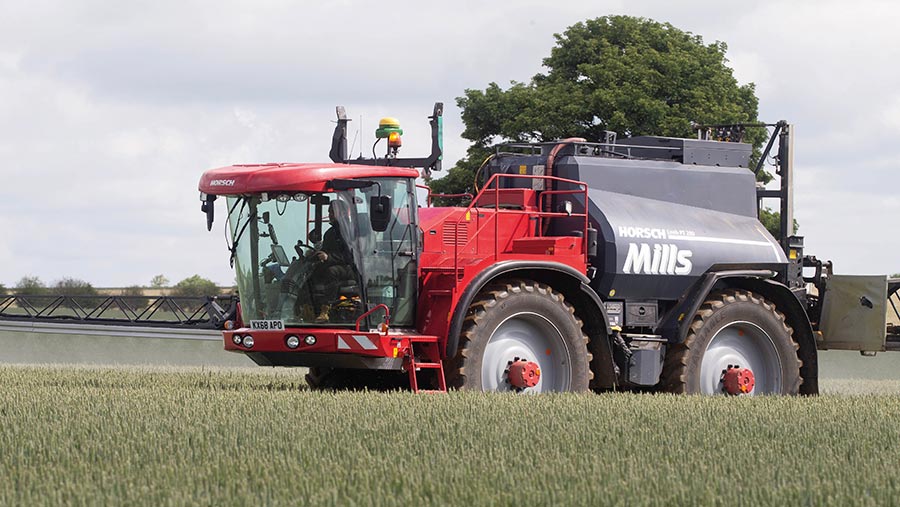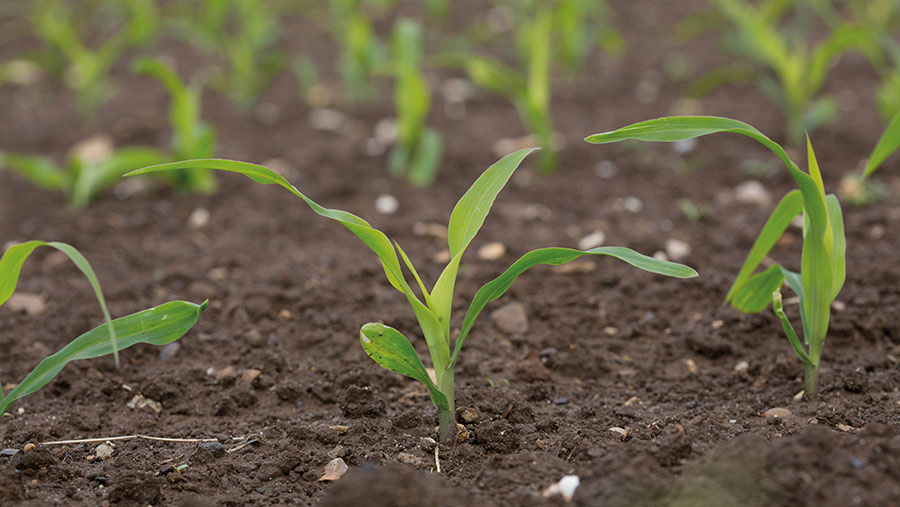Crop Watch: Recent rain helps ease pressure on dry crops
 © Tim Scrivener
© Tim Scrivener Thoughts are now turning to harvest, with most winter cereals looking in a good condition as T3 wheat fungicides and liquid nitrogen fertiliser being applied on milling wheats.
On the other hand, many spring cereals are looking shorter and thinner than usual after the dry spring, and many crops of spring beans could do with more rain to help the pods fill out.
See also: Optimism for blackgrass control grows with new herbicide Luximo
South
Oliver Bennetts
Zantra (Kent)
Some welcome rain over the past month has eased pressure on crops in the south.
My cereal crops are falling into two categories: well established winter crops that will now finish with a good potential yield, and later-sown winter ones along with spring-sown crops that have improved after the recent rains.
This year, T3 fungicides have been recommended on milling varieties to help ensure good grain quality on the top of a well-managed programme.
Crop values and premiums remain good, so investing in a T3 application will help control late season disease which can have an impact on all areas of quality such as mycotoxin levels, specific weights and storage.
Additional rust control had to be considered when planning T3s.
While disease levels have been fairly low this season, yellow rust has been present (with what looks to be newer, more resilient strains leading to increased issues in some varieties).
In addition to yellow rust, hot dry conditions in June are also ideal for brown rust, with infections reaching a peak at the end of the month.
If you can get to a variety trial site nearby, I would urge you to, to help with your decisions for the new season.
Helped by the nice weather and some recent irrigation, potato crops are really moving through tuber initiation, with most crops meeting in the rows, and at the rate they are growing it won’t be long before they are at full canopy.
Blight control is at the forefront of my mind and with the irrigator going on in fields, which will increase the pressure.
It is important to keep on top of your applications and don’t stretch the intervals too much.
Peas and beans seem to have gone from zero to 100 in the past two or three weeks, with peas doubling if not tripling in size.
These crops are in full flower, with the first pods visible. Aphids are being found in both crops, so an application of pirimicarb has been going on where needed.
Looking slightly ahead, foliar urea applications are being planned at early grain fill, to help boost the protein levels in milling wheats.
As ever, these products need to be applied early in the morning or in the evening, to avoid scorch in the midday sun – especially if there is a drying breeze as well.
In a matter of weeks, the combines will be out and rolling, taking in everything we have worked for all year, and so the cycle will begin again…
As this is my last article of the season, all that is left for me to do is say good luck and hope you all a have good harvest.
North
Patrick Stephenson
AICC (Yorkshire)
After staying on top of spraying programmes all year, the wheels finally came off the trolley in the past few weeks.
The guilty parties were wind, silage and sprayer diaphragms. Coming at a time when everyone has end-of-season fatigue, this is not a happy combination.
All in all, crops look good and full of promise, but that means nothing until they are all safely gathered in.
Sadly, the joy of watching the crops race through growth stages is soon over, as all the detritus in the fields also comes to the party. Blackgrass, ryegrass, and the brome species all start to show.
I am starting to believe that the use of grassweed herbicides in the spring is not the optimum timing.
Each year I make excuses for poor control and although there may be some mileage in this, I suspect autumn is probably the most appropriate timing.
Driving around and reading the social media feeds, it would appear that having bad blackgrass is now de rigueur, and if you haven’t got horrendous brome or ryegrass, you are not a proper farmer.
As a consequence, I can’t decide if the half-submerged plough at the Groundswell event is an emerging piece of equipment here to save us.
Winter barley crops are now ripening nicely. All year it has been a mixed love affair, swinging from looking good to looking awful.
Fortunately, they appear to be finishing on the nice spectrum, so fingers crossed.
Spring barley has raced through the growth stages and ears are now emerged, so there will be some awn sprays, although this will not be standard.
T3 sprays are now complete and, although I can find aphids building up slowly with limited armoury in the cupboard, I wonder why I am bothering.
Having stood in numerous fields demonstrating wheat varieties, I can tell you that disease pressure varies greatly across the country.
Yellow rust is the one consistent factor at all the sites I have been to, although not always the same batch of varieties.
Septoria, on the other hand, has huge variation in its distribution. In regions that have had more rain, the levels of septoria are jaw-dropping.
Even with a fungicide programme of more than £200/ha, and including the best new chemistry, the disease has not been controlled.
I am now of the opinion that varieties with ratings of 5 and below for septoria carry the risk that we will not be able to control the disease.
Oilseed rape crops are now well on the way towards desiccation and the main decision to make is the inclusion of a pod sealent product.
Sadly, doing trials on pod sealants is fraught with difficulty, as to show they work you have to deliberately delay harvest.
This is a decision for each farmer based on their attitude to risk. With prices at the current high, many will err on the side of caution and use them.
East
Marcus Mann
Frontier (Essex)
In response to the recent warmer weather, harvest now feels as if it is just around the corner. Winter barley crops on the whole look well and are still standing.
Disease control has been good and as the crops start to senesce, we won’t have long to wait to see how well they yield.
Winter wheat crops are hanging in well, with T3s applied to all to protect the ear from fusarium infection and top-up rust and septoria protection.
However, there is still a long way to go for some of these crops, and while by no means a routine treatment, on the more yellow rust-prone varieties an additional treatment may be justified to preserve the investment already made.
Levels of late-season brown rust are increasing on susceptible varieties, for example Crusoe.
As for yellow rust, treatment may be required but be mindful of the latest timings data on product labels.
It is worth considering gaining resistance tests on remaining grassweed patches.
For ryegrass, which is becoming an increasingly concerning issue, collecting samples and understanding its susceptibility to different modes of action could prove useful for the following year.
Spring crops still have a long way to go. In pulses, bean rust is increasing and with current hot conditions the pressure will remain high.
Fortunately, there is further chemistry available this year with the approval of benzovindiflupyr. However, still ensure T1 and T2 do not get stretched to avoid bean rust spreading through the crop.
In sugar beet, there is a low incidence of large beet plants showing yellowing in the oldest leaves, which suggests there was little early infection with virus yellows.
However, it remains important to protect against aphids up to beet at 16 leaves, to prevent its spread and late infections.
As we approach July, thoughts are turning to protection against foliar diseases. Avoid applying fungicides before disease is seen, especially in crops with a significant number of late-emerged beets.
It won’t be long before we begin discussing winter oilseed rape establishment.
The key to achieving good establishment is to preserve moisture and ensure adequate nutrition, to support ground biomass and help the crop to continue its growth throughout the autumn.
Hybrid varieties can certainly help mitigate damage through their vigorous autumn growth, and their lower seed rates prevent over-competition, supporting thicker, more robust stem growth.
When deciding on varieties to grow, always check spring growth habits, as this has become more important to help the crop grow away from both cabbage stem flea beetle larvae and pigeon damage.

© Tim Scrivener
West
Giles Simpson
Pearce Seeds (Somerset)
The recent weather has allowed any follow-up maize herbicides to be applied. The pre-emergence sprays have worked very well and, in some situations, no follow-up has been needed.
The delay in spraying due to the wind did exaggerate the difference between fields that had pre-emergence and the ones that did not.
On this year’s results you would definitely apply a pre-emergence on all maize fields next year. Your costs maybe slightly higher, but there has been less weed competition which should mean a higher yield.
The winter barleys on the whole look very well and are beginning to ripen very quickly, the old saying of “when you think it’s fit to cut, go on holiday for a week” always sticks with me at this time of year and, with the price of fuel, you want to be trying to cut the crop when it is fit and not in need of drying.
The winter wheats have received an ear wash and, with the recent showers and then hot weather, I am glad we have done them.
On the whole, they look promising, but we do need some decent weather from now on – we don’t need extremes either way.
The spring crops have raced through the growth stages and are nearly all out in ear now, with the last fungicide applied.
They all seem to be rather short. Maybe I overdid the growth regulator, but at least it will be stood up.
The fodder beet that I have all looks really neat in rows. The flea beetle had a go at some, but luckily it has come through.
The pre-emergence sprays have done a good job, like in the maize, and the first post-emergence spray has been applied. Hopefully this will be all that is required until a fungicide later on.
Grass growth has been good and quite a lot of second-cut silage has been done already, with good yield and quality. The grass did bolt a little due to stress, which I think is down to a lack of moisture as the ground is still very dry underneath.
The hot weather last week allowed for hay to be made, and again yield was very good and the quality looking good. This should all help to reduce the bought-in feed costs next winter.
As most of my customers are dairy-orientated, the cropping plans and rotations won’t change much.
What I do think will happen is that more soil, slurry and manure sampling will take place, so that we can best place the nutrients where they are needed.
This year it has worked well and forage yields have been good, but who knows what will happen in another year?

